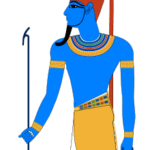Amenhotep is a significant figure in Egyptian mythology and history. His name means “Amun is satisfied,” reflecting the importance of the god Amun in ancient Egyptian religion. Amenhotep was a common name for several pharaohs, the most notable being Amenhotep III and Amenhotep IV, who later changed his name to Akhenaten. Each of these rulers contributed to the rich tapestry of Egyptian culture and religious practices during their reigns. In this article, we will explore the life, achievements, and religious significance of Amenhotep and his impact on ancient Egypt.
Amenhotep III: The Magnificent Pharaoh
Amenhotep III ruled during the 18th Dynasty, around 1386 to 1349 BCE. He is often considered one of the most powerful and prosperous pharaohs of ancient Egypt. His reign was marked by a flourishing of the arts, architecture, and international diplomacy. The period of Amenhotep III is often referred to as the “Golden Age” of ancient Egypt. He built numerous temples, monuments, and statues that celebrated his achievements and the gods he worshipped.
 Amun-ra
Amun-raOne of the most significant contributions of Amenhotep III was the construction of the Luxor Temple and the Karnak Temple complex. These structures were dedicated to Amun and showcased the pharaoh’s devotion to the gods. The Luxor Temple, in particular, was designed to celebrate the rejuvenation of kingship and the divine connection between the pharaoh and the gods. It served as a place for important religious rituals and ceremonies.
Amenhotep III also engaged in extensive diplomatic relations with neighboring kingdoms. He married several foreign princesses, which helped to secure alliances and promote peace. His reign saw a flourishing of trade and cultural exchange, making Egypt a powerful player in the ancient world. The pharaoh’s ability to maintain stability and prosperity during his reign left a lasting legacy for his successors.
Amenhotep IV: The Revolutionary Pharaoh
Amenhotep IV, who later became known as Akhenaten, was the son of Amenhotep III. He ruled from around 1353 to 1336 BCE and is best known for his radical religious reforms. Akhenaten shifted the focus of Egyptian worship from the traditional pantheon of gods to the exclusive worship of the sun disk, known as Aten. This marked a significant departure from centuries of polytheistic practices in Egypt.
 Amun
AmunAkhenaten established a new capital city called Akhetaten (modern-day Amarna) dedicated to Aten. He constructed temples and monuments to honor the sun disk, and he promoted a new artistic style that emphasized realism and the depiction of the royal family in everyday life. This change in artistic representation was a departure from the idealized forms that characterized earlier periods of Egyptian art.
The religious reforms of Akhenaten were controversial and met with resistance from the powerful priesthood of Amun. Many Egyptians were deeply attached to their traditional beliefs and practices. As a result, Akhenaten’s reforms were not widely accepted, and after his death, the worship of Aten quickly fell out of favor. His successors, including Tutankhamun, restored the traditional religious practices and returned to the worship of Amun.
The Legacy of Amenhotep
The legacy of Amenhotep III and Amenhotep IV is complex and multifaceted. Amenhotep III is remembered for his contributions to the arts, architecture, and international relations. His reign is often viewed as a pinnacle of ancient Egyptian civilization, characterized by stability and prosperity. The monuments he built, including the famous Colossi of Memnon, continue to attract visitors and scholars today.
 Amaunet
AmaunetOn the other hand, Akhenaten’s legacy is more controversial. His attempt to impose monotheism was largely rejected by the people of Egypt, and his reign is often seen as a time of turmoil and upheaval. However, some scholars argue that Akhenaten’s reforms laid the groundwork for later religious developments in Egypt and influenced the emergence of monotheistic beliefs in the region.
Despite the differing legacies of these two pharaohs, both Amenhotep III and Akhenaten played crucial roles in shaping the religious landscape of ancient Egypt. Their stories reflect the dynamic nature of Egyptian mythology and the ways in which religion and politics intertwined throughout history.
The Worship of Amun
Amun was one of the most important gods in ancient Egyptian religion, and his worship reached its peak during the reign of Amenhotep III. He was often depicted as a man with a ram’s head or as a ram, symbolizing strength and fertility. Amun was associated with the sun and air, and he was considered the king of the gods. His temple at Karnak became a central place of worship and pilgrimage for Egyptians.
The priests of Amun held significant power and influence in society. They managed the temple’s wealth, conducted rituals, and played a vital role in the political landscape of ancient Egypt. The relationship between the pharaoh and the priesthood of Amun was crucial, as the pharaoh was seen as the earthly representative of the gods. This connection legitimized the pharaoh’s rule and ensured the support of the people.
During Amenhotep III’s reign, the worship of Amun was closely linked to the concept of divine kingship. The pharaoh was believed to be the son of Amun, and his authority was derived from this divine connection. The construction of grand temples and monuments dedicated to Amun served to reinforce this idea and demonstrate the pharaoh’s devotion to the gods.
The Artistic Achievements of Amenhotep III
The reign of Amenhotep III is often characterized by remarkable artistic achievements that reflect the wealth and power of his rule. The period saw a significant development in the arts, with advancements in sculpture, painting, and architecture. Artists were commissioned to create stunning works that celebrated the pharaoh, the gods, and daily life in ancient Egypt.
One of the most notable artistic innovations during Amenhotep III’s reign was the use of realism in sculpture and painting. Unlike the idealized forms of earlier periods, artists began to depict more lifelike representations of the human figure. This shift allowed for a greater expression of individuality and emotion in art, making it more relatable to the viewers.
The large-scale statues of Amenhotep III, such as the Colossi of Memnon, are prime examples of the artistic grandeur of this era. These colossal statues were designed to impress and intimidate, showcasing the pharaoh’s power and divine connection. The intricate carvings and detailed features of these statues highlight the skill and craftsmanship of ancient Egyptian artists.
The Role of Women in Amenhotep’s Reign
The reign of Amenhotep III is also notable for the prominent role of women in the royal court. The pharaoh’s principal wife, Queen Tiye, was a powerful figure in her own right. She played an active role in political affairs and was involved in diplomatic correspondence with foreign leaders. Queen Tiye’s influence extended beyond her husband’s reign, as she continued to be a significant figure during the rule of her son, Akhenaten.
Women in ancient Egypt, particularly those of royal lineage, enjoyed certain privileges and rights. They could own property, initiate divorce, and engage in business transactions. The presence of powerful queens like Tiye and Nefertiti, Akhenaten’s wife, demonstrates the potential for women to wield influence and authority in a male-dominated society.
The representation of women in art during Amenhotep III’s reign also reflected their elevated status. Queens were often depicted alongside their husbands in a manner that emphasized their importance and partnership in governance. This artistic portrayal contributed to the perception of women as integral figures in the political and religious landscape of ancient Egypt.
The Amarna Period: A Time of Change
The reign of Akhenaten marked the beginning of the Amarna Period, a time of significant change in ancient Egypt. The shift towards the worship of Aten and the establishment of Akhetaten as the new capital represented a departure from traditional practices. This period was characterized by a unique artistic style and a focus on the royal family, contrasting sharply with the earlier conventions of Egyptian art.
During the Amarna Period, artists produced works that depicted the royal family in a more intimate and personal manner. The art often showed Akhenaten, Nefertiti, and their children engaging in daily activities, highlighting the pharaoh’s desire to present himself as a caring and devoted father. This emphasis on family life was a notable departure from the more formal and distant representations of previous rulers.
However, the Amarna Period was not without its challenges. The religious reforms instituted by Akhenaten faced significant opposition, and after his death, there was a swift return to traditional worship practices. The temples of Amun were restored, and the worship of Aten declined, leading to a resurgence of the old religious order.
The Fall of the Amarna Period
The Amarna Period came to an end with the death of Akhenaten and the ascension of his son, Tutankhamun. The young pharaoh, guided by advisors, quickly reversed his father’s religious reforms and reinstated the worship of Amun. This shift was not only a political move but also a reflection of the people’s desire to return to the familiar religious practices that had defined their culture for centuries.
Tutankhamun’s reign was relatively short, lasting only about ten years, but it marked a crucial turning point in Egyptian history. The restoration of Amun’s worship was celebrated, and the temples that had fallen into disrepair during the Amarna Period were rebuilt and revitalized. This return to traditional beliefs helped to restore stability to the kingdom.
Despite the end of the Amarna Period, the legacy of Amenhotep III and Akhenaten continued to influence Egyptian culture and religion. The artistic innovations and religious ideas introduced during this time left a lasting mark on the development of ancient Egyptian civilization.
The Influence of Amenhotep on Later Generations
The impact of Amenhotep III and Akhenaten extended far beyond their lifetimes. Their reigns set the stage for future pharaohs and shaped the religious landscape of ancient Egypt. The artistic and architectural achievements of Amenhotep III inspired subsequent generations of artists and builders, who sought to emulate the grandeur of his monuments.
The religious turmoil initiated by Akhenaten’s reforms also had lasting effects on Egyptian society. While the immediate aftermath saw a return to traditional worship, the ideas surrounding monotheism and the exclusive worship of Aten continued to resonate. Some scholars suggest that these concepts may have influenced later religious developments in the region.
Moreover, the stories of Amenhotep III and Akhenaten have captured the imagination of historians and archaeologists, leading to ongoing research and exploration of their reigns. The discoveries at Amarna, including the royal tombs and artifacts, provide valuable insights into the daily life, beliefs, and practices of ancient Egyptians during this transformative period.
Conclusion: The Enduring Legacy of Amenhotep
The legacy of Amenhotep III and Amenhotep IV is a testament to the rich and complex history of ancient Egypt. Their reigns reflect the interplay between religion, politics, and culture, shaping the identity of a civilization that lasted for millennia. The achievements of these pharaohs continue to be celebrated and studied, reminding us of the enduring impact of their contributions to Egyptian mythology and history.
